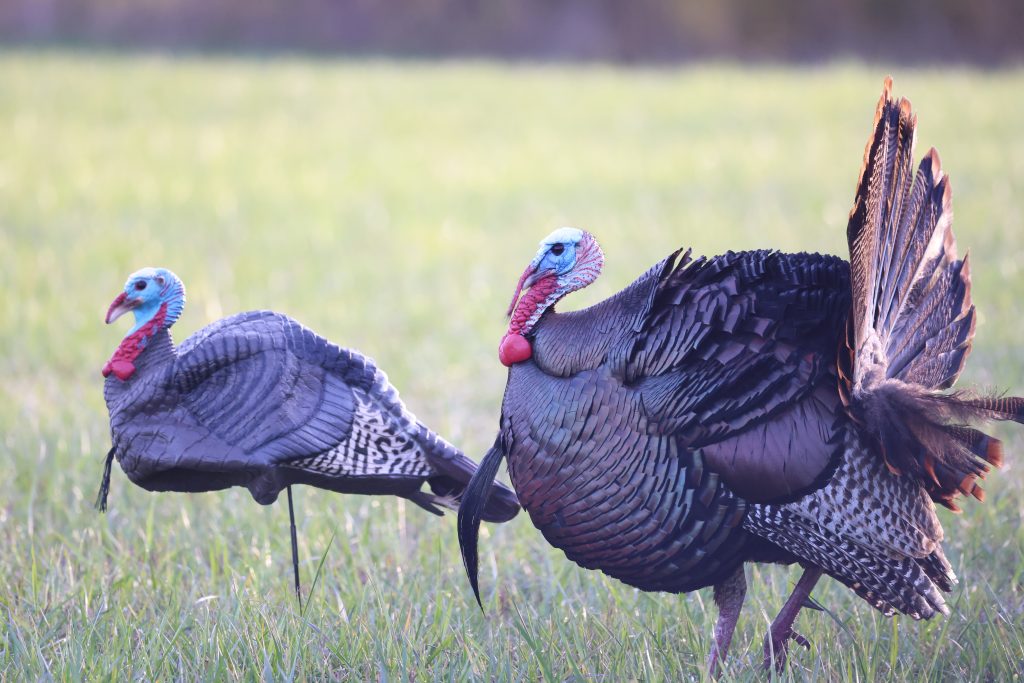The All-Day Turkey Hunting Game Plan
Craft a full-day game plan based on what turkeys typically do at certain times
Some states permit all-day turkey hunting. Others don’t. But for those that do, and for turkey hunters who plan to go daylight to dark, tactics should oftentimes change throughout the day. Here is a full-day game plan based on the general habits and tendencies of turkeys at certain times.
Daybreak
The first shift is daybreak. This is when birds are flying down from the roost and milling around their land zones and first feeding areas of the day.
The best play is to camp out over roost landing zones. These fly-down zones can put a gobbler in range right off the bat. Sometimes, turkeys drop straight down from the roost. Other times, they soar into the distance. Know where they typically land and set up accordingly.
Generally, aggressive calling is best. Early in the season, and where other hunters aren’t located, strutter decoys can work great, too.
Early Morning
After fly-down, turkeys tend to shift toward feeding areas that are further from their roost sites. Oftentimes, these are lower elevations, bottomlands, pastures, etc.
Regarding calling efforts, consider moderate calling aggressiveness and volume. Match your calling to the flock’s. Consider a strutter or jake decoy, and definitely deploy a hen decoy or two. Sometimes, hunters like to use a lot of decoys to attract a bird’s attention.
If calling to the gobbler doesn’t work, and they’re all henned up, call to the hens instead. That can work, too.

Late Morning
As the sun ascends higher and turkeys shift again, consider another move in tactics. Great late-morning turkey hunting spots include feeding areas, strut zones, dust bowls and more.
Consider hunting along the inside edges of cover. If turkeys aren’t in sight or within hearing distance, still hunt toward expected turkey locations.
At this point, unless a gobbler is fired up, use light to moderate calling aggressiveness and frequency. Try a jake and hen decoy pair to bring them in. If gobblers are still henned-up, continue calling to the hens instead.
Midday
As it reaches high noon, it’s time to think temperature. On hot days, focus on cooler areas. On cool days, that’s not as important.
Regardless, lower to mid-elevation areas, inside cover, in the timber, in pockets of timber and near water sources are solid spots to try. Again, if turkeys aren’t visible or audible, consider still-hunting, glassing and soft calling until you find birds or a promising spot.
As this point, light calling is best. Deploy a single jake and hen decoy or lone hen decoy.
Early Afternoon
As the sun starts to drop, turkeys start to change their location and tendencies yet again. Feeding areas, strut zones, dust bowls, nesting areas just outside of cover are solid spots to try.
If being stationary yields no fruit, try still hunting through some of the above areas. Use light to moderate calling. Deploy a jake and hen decoy or single hen decoy.
Late Afternoon
With only a few hours left, turkeys are beginning to head back toward the roost. That said, they’ll continue feeding until the last few minutes before fly-up. So, continue to hunt along food sources and field edges closer to roost sights.
Unless a gobbler gets fired up, consider light to moderate calling. Deploy a jake and hen or single hen decoy. Calling to a willing tom without hens can work. However, birds tend to get flocked back up by late afternoon. In that event, call to the hens instead. Or hope for a satellite tom.
Dusk
At dusk, the turkey hunting day is nearly over. While hunting close to roost sites has a high chance of pressuring birds or messing up the next day’s hunt, it can be a good play for the last day of your hunt or the last day of the season. All said, a better, safer play is sitting along transition routes that lead to roost sites.
Use light to moderate calling. Stake a jake and hen decoy, or set up a single hen. Sometimes, hunters like to use a lot of decoys to attract a bird’s attention.
Make a Plan
Regardless of the hour, it’s always important to analyze the situation and deploy tactics that match it. Try to anticipate what turkeys will do next, and remain a step ahead.
Note: Make sure to abide by legal shooting hours in the state you are hunting.
